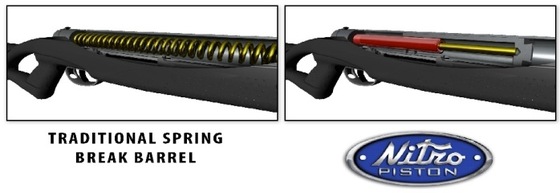In this Comparison Video I go through the benefits and shortcomings of CO2, Spring Piston and Pump Airguns. I focus mainly on Airguns but there is a bit of a crossover with Airsoft guns.
All three systems (CO2, Spring, Pump) create pressure that forces the ammunition with a high force out of the barrel. Similar to how gun powder is the source of energy for a bullet.
Here are some basic statements that best describe CO2, Spring Piston and Pump Airguns.

CO2 Airguns:
CO2 Airguns use the expansion of CO2 gas to create the pressure required for the ammo.
CO2 Airguns generally store enough CO2 for multiple shots per cartridge.
CO2 Airguns have a limit as to how much power they can produce since CO2 has a set vapor pressure of 850 psi, or about 56 bar at room temperature which is around 25 C or 77 F. CO2 Gas also requires a warm environment to expand so warmer temperature and longer barrels help with power.
Some CO2 guns can also use pressurized air tanks in place of CO2.

Spring Piston Airguns:
Spring Airguns use the release of a pre-cocked spring and plunger system to compress air to power the ammo.
Spring Piston Airguns require the cocking of the spring between each shot so they are single shot only.
Spring Airguns are limited to how much effort is humanly possible to cock the spring into position. If you make the spring to strong then not everyone will be able to use the Airgun effectively. Too week of a spring and the Airgun will lack power.
Spring Piston Airguns are known for having a fair amount of recoil and vibration when the spring moves both forward and backwards quickly inside the Airgun.
Spring Airguns can use either a mechanical spring or a gas spring.

Pump Airguns:
Pump Airguns (either Single or Multi-Pump) store air pressure in a chamber that when released, powers the ammo.
Most Pump Airguns require at least 1 or more pumps, often up to 10 pumps for each shot and you generally only get one shot per set of pumps. Not to be confused with PCP Airguns (Pre Charged Pneumatic) which have large pressure tanks that are recharged with a high volume of pressurized air that is capable of shooting multiple shots per charge.
Pump Airguns are also somewhat limited to how much effort is humanly possible since the higher the chamber pressure, the harder it will be to pump the Airgun.
Misc Airguns:
Generally speaking both Spring and Multi-Pump Airguns have more potential power than a CO2 guns since CO2 has a set peek pressure limit.
Pump and CO2 Airguns are know to have very little recoil since the pressure is stored in a chamber and then released by a valve. No slapping back and forth of a large internal spring.
Pros:
CO2 Airguns:
CO2 Airguns allow for multiple shots per CO2 cartridge for more realistic action shooting.
CO2 Airguns do not require any human effort to charge the gun other than loading the CO2 and Ammo into the Airgun.
CO2 Airguns allow for true semi auto shooting ability.
Spring Piston Airguns:
Spring Airguns have the potential for high velocity since the larger and stiffer the spring, the greater the output force.
Spring Airguns do not require anything other than your ammunition, typically either a Pellet or BB.
Spring Airguns are mechanically very simple which makes them very reliable and less expensive to produce than other types of Airguns.
Pump Airguns:
Pump Airguns have the potential for high velocity since more pumps equals greater output force, only limited by the users strength and the pressure rating of the Airgun.
Pump Airguns do not require anything other than your ammunition, typically either a Pellet or BB.
Pump Airguns have next to no recoil which makes them very easy to shoot and highly accurate.
Cons:
CO2 Airguns:
CO2 Airguns require the purchase and use of CO2 or they simple do not work.
CO2 Airguns are very susceptible to temperature changes, especially cold temperature since CO2 needs a warm environment in order to expand. Cool down effect also plays a role in power output.
CO2 Airguns have a maximum set amount of power output.
Spring Piston Airguns:
Spring Airguns require the pre-cocking of the spring for each shot.
Spring Airguns can take some getting used to since the spring recoil/vibration requires a very lose grip (Military Grip) to shoot accurately with them.
Spring Airguns should not be stored pre-cocked since this can damage the spring, less so with gas spring versions.
Pump Airguns:
Pump Airguns require pre-pumping to pressurize the air chamber for each shot.
Pump Airguns, especially Multi-Pump Airguns take the most amount of human effort for each shot.
Pump Airguns need to stored with at least one pump in them or the seals can get damaged over time.

